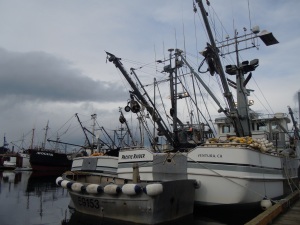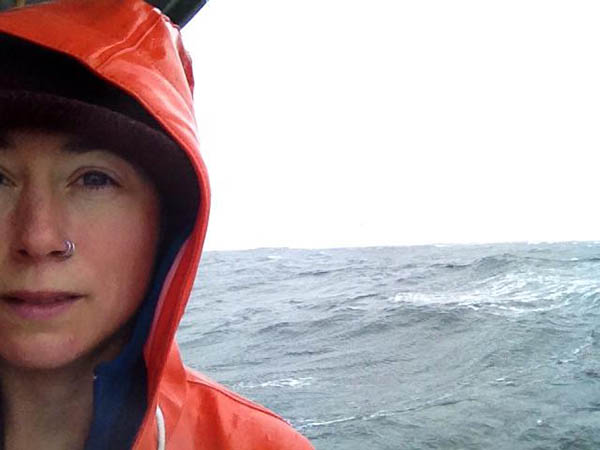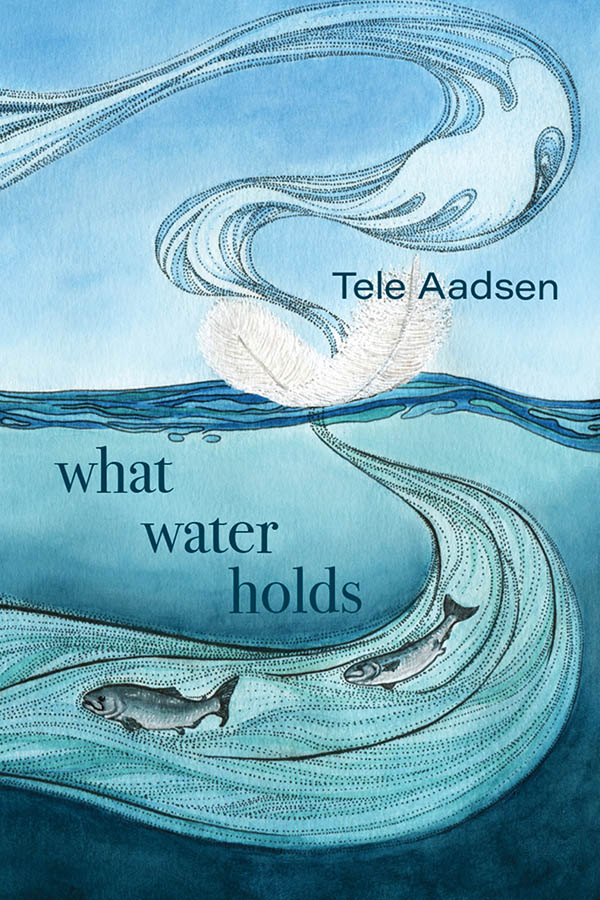When Cap’n J and I arrived in Sitka last week, we found the harbor packed with seiners, decks loaded with coiled nets, and the air near-electric. As captains and crew paced the docks, I found it easy to imagine their boats as equally impatient – steel and fiberglass racehorses pawing the ground, nostrils flared as they waited for the gate to open.
Spring in Sitka means herring. If there’s a Southeast Alaska runner-up to Deadliest Catch’s rock star madness, it’s this – the Herring Sac Roe Fishery. You can follow the frenzy from wherever you are: JuneauTek always provides excellent coverage, and Youtube is plugged with testosterone-drenched videos like this one. Scenes of combat fishing, engines screaming as boats slam-dance over who’ll set their net in the sweetest spot. With 48 permit-holders and openings that last mere hours, competition is ferocious.
(I’m told that the Coast Guard is putting their foot down this year. Any boats ramming another, they’ve promised, “We’ll shut this thing right down,” like a fed-up parent shouting from the car’s front seat. Sure. But cowboy culture is hard to police. Walking through the harbor, I notice boats necklaced with neon chains of rubber buoys, their bows so thick with inflatable cushioning that the vessel’s name isn’t visible.)
Anticipation further heightens the intensity. On Monday, the Alaska Department of Fish & Game put the fleet on two-hour notice. Biologists take daily test samples of roe, monitoring the eggs’ maturity level. When that level reaches 11%, ADF&G will give the fleet the green light, allowing at least two hours’ notice for everyone to jockey into position before the gun goes off. Management biologist Dave Gordon shares updates on the day’s findings over the VHF radio. Yesterday, he summed up the slow roe development with a call for continued patience. “We will continue to monitor the distribution of fish.”
I don’t have any connection to this fishery, yet even I’m caught up in the excitement, eager to witness an explosive exodus from the harbor. Herring is a Big Deal, and never more so than this year. After last year’s then-record quota of 19,430 tons, ADF&G determined past calculations had underestimated the biomass. The 2012 quota skyrocketed to a new high: 28,829 tons.
Veteran status in one fishery doesn’t make you knowledgeable in another. With my seasons limited to trolling, longlining, and shrimping, the XtraTufs on my feet and crew license in my wallet are all I share with a herring deckhand’s experience. Trollers drag their hooks around for up to 18 hours a day, striving to catch at least 100 coho, one fish at a time. The longliners I’ve crewed on have fished relatively small quotas – 15,000 pounds of halibut here, 20,000 pounds of black cod there. And my shrimping memories are fond recollections of the mellowest ocean-labor I’ve had. Coming from such comparatively small potato ventures, I found it impossible to conceptualize almost 29,000 tons of herring.
I wasn’t the only one. Jeff Feldpausch, the Sitka Tribe of Alaska’s Resource Protection Director, asked himself what that number really meant. What does 57 million pounds of herring look like?
Imagine a football field… Over 20 feet high.
Imagine the Empire State Building… 77 times as tall.
The Sitka Tribe released a series of ads protesting the quota as excessive, and Jeff spoke with Raven Radio, further explaining the concerns. Herring are what’s known as a keystone forage fish – that is, a vital part of the marine ecosystem. A critical food source for salmon, halibut, and humpback whales, herring are the only forage fish that’s commercially harvested in Alaska.
“What happens if you cut out the bottom of the food chain?” Jeff asked. “Everyone above collapses.”
If herring’s value in the ecosystem is near-priceless, I figured, its economic value must be astronomical. But that’s a tough one to gauge. Virtually all of this fishery’s catch is shipped to Japan, where the sac roe — kazunoko — is a high-end traditional food, a New Year’s delicacy. After much speculation on how last year’s tsunami would impact the market, the wholesale value fell $500/ton, crashing down to $150-$200/ton. This year’s price remains an unknown.

Kazunoko: a Japanese New Year’s delicacy. Photo from www.tastefood.info
Beyond Japan’s ravaged infrastructure, some fear their food culture is changing. Tlingit elder Ray Nielsen believes kazunoko is a declining market. “The young people, they eat at McDonald’s. There’s no money in this anymore. It’s just an ego fishery now. Everyone wants the big sets.”
As I sat at the Backdoor Café considering all this, a friend noticed the Tribe’s flyers on my table. “Propaganda,” she scoffed. “There’s a lot of fish out there.”
Maybe. I hope so. ADF&G points out that the quota is only 20% of the biomass; using the football example, the remaining herring will tower over 80 feet above the field. And as a troller, all of my experience with ADF&G has been positive. I’m impressed with their salmon management, thankful that their strict supervision has contributed to abundant runs and a strong industry. I have no reason to doubt their biologists.
But excess in all forms makes me anxious. A little voice deep within cries, What if we’re wrong?

Art by Ray Troll.
I’ll be the first to admit I don’t speak from first-hand knowledge, and regular Hooked readers know I’m sensitive to the notion of “enough.” So what do you think? Wherever folks fall on this issue, it’s one we should consider. Your experiences and observations are welcome here; thanks for keeping it civil.




How could erring (pun intended) on the side of caution be wrong? Those 48 boats stand to make a ton of cash, especially compared to the average SE troller or Cook Inlet gillnetter, even if the quota stayed the same as last year. “What if” w’re wrong? I am glad for the biologists who run the fishery, but I don’t think for a second that they’ve figured out all the variables that impact fish stocks. They’ve historically been wrong waaay more times than they’ve been right. Good article. Thought-provoking. Still, I’d LOVE to come see the rodeo some day.
Thanks for starting the discussion, Pat! I’m right there with you — uneasy, cautious, wondering about the long-range vision — yet somehow attracted to the spectacle of it all. When Joel and I got up here, we were all excited to see the show. Still feel that way, but with a dawning sense of greater complexities than we were aware of.
Tele:
Well articulated with all those question marks that don’t point, but remind us to keep questioning and not take the simple roads.
Ellen, thanks for encouraging this post when it was just a vague thought of unease. Maybe you’ve found this to be true in your own work… Seems like some of the stuff that’s hard to talk about become more natural when we put more attention to questioning than determining. Looking forward to continuing the conversations and learning more.
Great post,
I have a tendency to agree with some of the STA concerns, this fishery has become a shell of it’s former self, and the intent of the fishermen who started this fishery over 40 years ago has been lost. The market price is poor, time to try new product forms, or don’t fish the entire quota, rather than saturating the market with product people don’t want or willing to pay for. It has become a testosterone driven fishery. The ADFG and it’s biologists are the best in the world, but to err is human.
Thanks so much for your contribution, Jason. Did I understand correctly that you grew up in this fishery? I’d love to hear more about the history and that original intent you mentioned. Do the current 48 permit-holders include many guys from the fishery’s early days? Why do you think the fishery has changed? What’s your sense from other seiners — concerns, no problem, mixed?
Hey Tele. I feel that being conservative when it comes to anything living is the way to go. Those herring won’t be swimming anymore, nor feeding those other fish. I get a bad feeling in my stomach when it comes to ego fishing/hunting or fishing/hunting in excess.
You know those hot dog contests to see who can eat the most? And then they throw up afterwards? How can you have even a surface knowledge about hunger and not be outraged? Sorry…Excess leaves me with a terrible taste.
I don’t mean to preach. But i feel that as living beings we should only end the lives of what can and will sustain us. No more. No less. I feel that a true fisherman’s heart is one that values & respects the sea and all it contains. I know that you and Cap’n J operate that way, as well as many fishermen. But we vary in as many ways as we intersect.
What to do? You are right to worry. And you are right to be curious about any spectacle.
I hope they are right, too. You, Cap’n J and Bear take very good care.
It doesn’t seem to make a lot of business sense to harvest so many more fish when the demand/price is decreasing.
I’m also worried about taking forage fish that are at the bottom of the food chain and are so critical for the rest of the ecosystem.
I want to trust ADFG and their science, but we just had a 33% increase because of an ERROR that they made in one tiny aspect of their model (microscope interpretation of fish ages). What if there is another mistake waiting to be found that means we should be decreasing the harvest by 33%?
Very valid points, Andrew. I’m hearing a lot of talk on the dock about the schism of flooding the decreased market when demand is so (comparatively) low. Definitely a lot of folks watching to see how this year will shake out.
The mention of these errors certainly gives one cause for pause. Good for you for the questions you raise, Tele. Your blog is such an education. I’m so looking forward to hosting you over on mine and, guess what? I LOVE this about the blogosphere … today I hosted Claire McAlpine, a blogger I follow who lives in Aix En Provence. We met through my posts about France. I noticed on her site that she follows you too! So we then had a chat about how awesome your blog is … coincidences like this make me feel good all over.
Thanks for chiming in, Patricia! I’d wondered if this one wouldn’t be a bit too “fishy” for Hooked’s land-based readers, and definitely appreciate your (and others’) indulgence in staying with me through these more industry-based observations. Seems like an important thing, having these conversations with a larger, more diverse pool of folks.
That’s a fantastic connection with Claire, and I’m delighted to hear that she was one of your guests! I’ll look forward to jumping over and reading that one. You’re so skilled at facilitating connections, Patricia, making the blogosphere a warmer, friendlier neighborhood! Thanks for having such a strong community spirit.
Always appreciate your insights. Thanks
Always appreciate your insights, thanks.
Nice to hear from you, Herb — I’ve been wondering how you and Laura are doing, what you’re up to these days. Hope all’s well.
According to Dave Gordon, this is a very imperfect science, but he is obligated to justify the quota based on the data they have. The Canadians have done some genetic research and the herring of SE AK are all one genetic group. It used to be that there were huge spawns all up and down Chatham. There are no longer enough for commercial harvests anywhere there. Some areas have crashed in the past. It appears that the conditions in Sitka Sound right now are good for these herring, but why not let nature control them? Why go above the 13,000 tons that used to be the high harvest. Seems very unwise to me.
Scary stuff from Canada. I have a buddy originally from BC, who shared this post with her friends; am hoping that we’ll hear from some of them on their experience. I keep hoping we’ll start learning from others…
Marian, you made a really good point about Dave’s obligations. Folks outside of our industries don’t have a concept of how these quotas and management plans come to be, that it’s the Board of Fisheries handing a decision down to ADF&G to implement and enforce. Tough position to be in… I don’t envy Dave or Pattie their jobs.
Always good to hear your perspective, Marian.
Hi Tele, I am now on board with your blog. I enjoyed reading your thoughts and the ensuing discussion on the herring fishery.
Steve — so nice to have you on board! Welcome, friend.
The arrival of herring in Sitka marks the arrival of Spring in Southeast Alaska, so the thrill of it all goes WAY-WAY-WAY beyond just catching a herring. From the git-go, herring strikes off the years fishing seasons, and harvests from the sea, land & air. It is a way of life that only a few are blessed to know & now continue to live.… I miss it with all my heart, but my tired out body could never do the fisheries anymore. The herring go to Gods country first to feed the people! Have a Great Fishing Season & May Our Creator Bless you with good health & much happy-ness.
Here is a Raven Radio story following up on the fishery that makes some interesting points:
http://www.kcaw.org/2012/04/30/after-harvest-sitka-tribe-renews-herring-concerns/